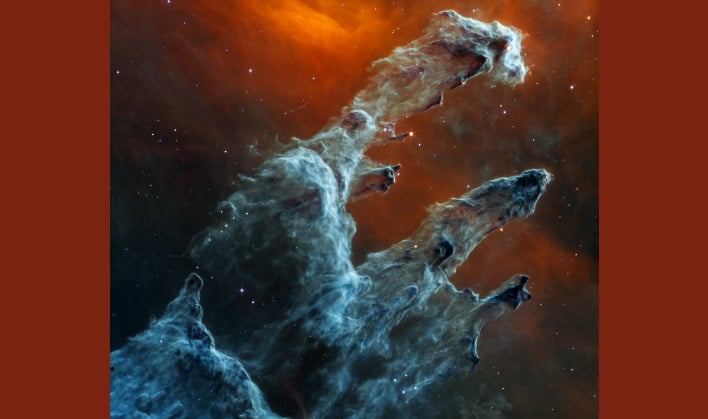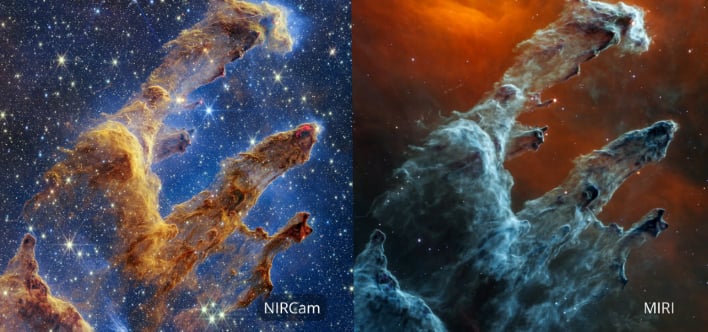NASA’s Webb Telescope Reveals Chilling Ghostly Structures In The Pillars Of Creation
NASA's Webb telescope captured an image of the Pillars of Creation that looks like the hand of the Grim Reaper reaching out from the very soul of the universe. The pillars were first made famous by the Hubble Space Telescope back in 1995.
Webb recently captured the Pillars of Creation with its Near-Infrared Camera (NIRCam), showcasing the interstellar gas and dust that make up the eerie columns. In that image, young stars that regularly shoot out supersonic jets that collide with clouds of material can be seen as wavy lines, appearing like lava at the edges of some of the pillars. NASA just released a new image captured of the pillars by Webb, this time with its Mid-Infrared Instrument (MIRI), and it is rather fitting for the Halloween holiday.
NASA says that the new image appears in a "somber, chilling mood," because the light of the stars are not bright enough at the wavelengths captured by MIRI to appear. This was quite different when Webb photographed the pillars with its NIRCam, as stars seemed to be dancing all around. However, MIRI views young stars that have yet to cast off their "dusty cloaks." These stars appear as crimson red orbs toward the fringes of the pillars. In comparison, the blue stars that litter the image are aging, which indicates they have gotten rid of most of their layers of gas and dust.
MIRI captures the mid-infrared light in great detail, as the densest areas of dust can be seen as the darkest shades of gray. The red V that is seen toward the top of the image is where the dust is cooler. The dust and gas also cloak the galaxies in the densest part of the Milky Way, which lie beyond the pillars.
To get an idea of just how vast this region of space is, NASA says, "Trace the topmost pillar, landing on the bright red star jutting out of its lower edge like a broomstick. This star and its dusty shroud are larger than the size of the our entire solar system."
Each time the Pillars of Creation are imaged, astronomers and scientists gain a better understanding of our universe. Webb has provided imagery with new wavelengths of light and advanced instruments, which enable more accurate counts of the gas, dust, and stars. All of this new data aides researchers to create more intricate models of how stars are formed.
Webb recently captured the Pillars of Creation with its Near-Infrared Camera (NIRCam), showcasing the interstellar gas and dust that make up the eerie columns. In that image, young stars that regularly shoot out supersonic jets that collide with clouds of material can be seen as wavy lines, appearing like lava at the edges of some of the pillars. NASA just released a new image captured of the pillars by Webb, this time with its Mid-Infrared Instrument (MIRI), and it is rather fitting for the Halloween holiday.
NASA says that the new image appears in a "somber, chilling mood," because the light of the stars are not bright enough at the wavelengths captured by MIRI to appear. This was quite different when Webb photographed the pillars with its NIRCam, as stars seemed to be dancing all around. However, MIRI views young stars that have yet to cast off their "dusty cloaks." These stars appear as crimson red orbs toward the fringes of the pillars. In comparison, the blue stars that litter the image are aging, which indicates they have gotten rid of most of their layers of gas and dust.
MIRI captures the mid-infrared light in great detail, as the densest areas of dust can be seen as the darkest shades of gray. The red V that is seen toward the top of the image is where the dust is cooler. The dust and gas also cloak the galaxies in the densest part of the Milky Way, which lie beyond the pillars.
To get an idea of just how vast this region of space is, NASA says, "Trace the topmost pillar, landing on the bright red star jutting out of its lower edge like a broomstick. This star and its dusty shroud are larger than the size of the our entire solar system."
Each time the Pillars of Creation are imaged, astronomers and scientists gain a better understanding of our universe. Webb has provided imagery with new wavelengths of light and advanced instruments, which enable more accurate counts of the gas, dust, and stars. All of this new data aides researchers to create more intricate models of how stars are formed.



